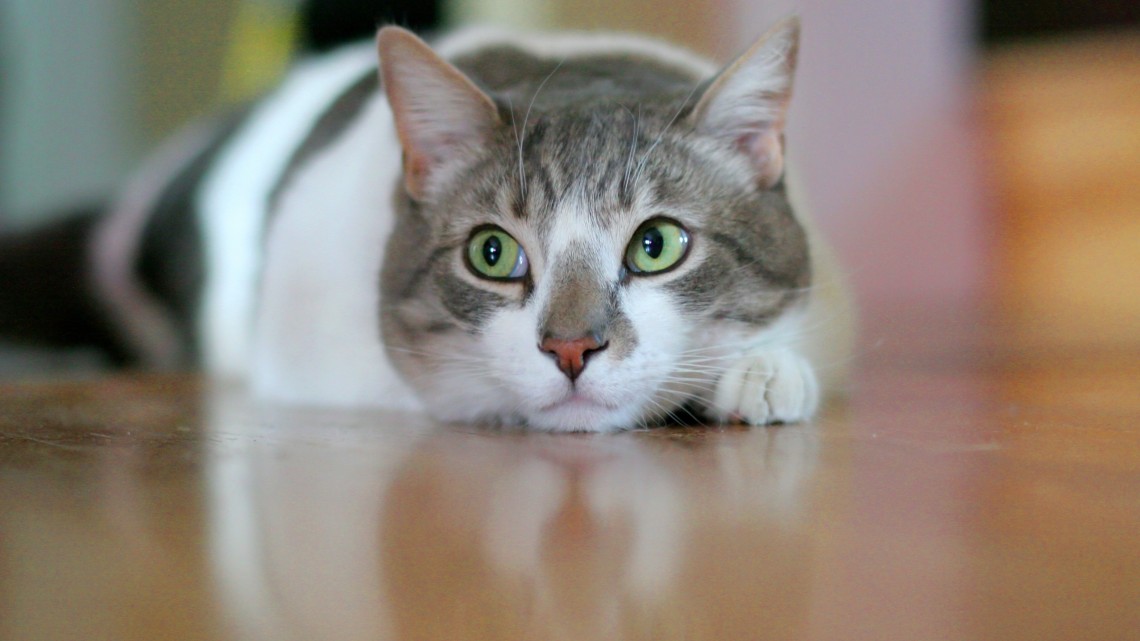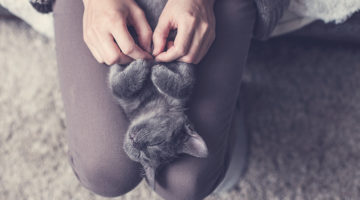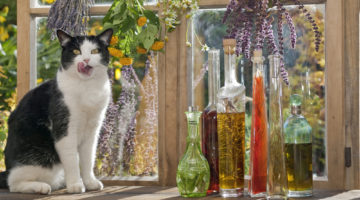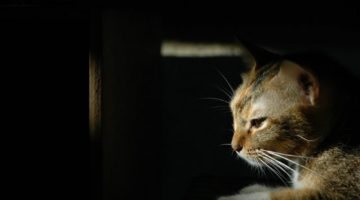It’s true that cats sleep more than we and other animals do…but they still don’t spend as much time in the land of nod as you might think.
When people think of cats, they often visualize a fluffy feline perched on a cat condo or window seat, fast asleep. Why is it that sleep is often the first thing that comes to mind in connection with kitties? It’s because a lot of us think cats sleep most of the time. But is this really true? Do our cats really sleep their lives away? The answer is yes…and no. Cats do sleep more than people and many other animals, but probably not as much as you think.
Studying feline sleep
Laboratory studies of cat sleep (and cats have been the subject of quite a few sleep studies!) show they slumber anywhere from 11 to 16 hours a day, or roughly 46% to 67% of the time. Kittens and very old cats sleep more.
How much a cat sleeps depends on a variety of factors:
The light cycle – the more hours of darkness, the more your cat sleeps.
Feeding schedule – more food and frequent feeding leads to increased sleep.
The presence of other animals and people – the more there are, the less a cat sleeps.
How stimulating the environment is – bored cats sleep more.
Note that these results are for cats in a controlled laboratory setting. Household cats, whether they live indoors or have outdoor access, may all sleep more or less due of variations in these factors.
Night and day
Often we think of cats as nocturnal – active at night and sleeping during the day. Cats in a sleep study lab setting are often more active during the day and sleep more at night. But this may be because they’re adjusting their sleep habits relative to what’s going on around them.
Studies of feral and outdoor cats show them to be mostly crepuscular (your new word for the day, meaning active at dawn and dusk), with a little more activity after dark. Consequently, they sleep more in the middle of the day and at night. This makes sense given what we’ve learned from the factors influencing sleep. It also means that altering these factors can influence your cat’s sleep behavior.
Cat naps
Two other factors that make it seem as if your kitty is sleeping more than she is include the pattern of her sleep and the presence of “drowsy” behavior. We humans do most of our sleeping all at once, for about seven or eight hours straight at night. Cats, on the other hand, have several shorter sleeps spaced throughout the day. This is where the term “cat nap” comes from. So if it seems that every time you turn around you see your cat sleeping, keep in mind that each period of sleep may last only a few minutes. Even though cats may take many short sleeps, this doesn’t mean they are sleeping most of the day.
If it seems that every time you turn around you see your cat sleeping, keep in mind that each period of sleep may last only a few minutes.
Secondly, what at first glance may appear to be sleep might not be. We’ve all seen our cats lying quietly with their eyes closed, and assumed they were asleep. But with the slightest disturbance, they open their eyes and look around. They aren’t really asleep, but instead in a drowsy, pre-sleep state. Cats can be in this state for up to three hours a day. We often mistake it for sleep.
Why do cats sleep a lot?
If cats are sleeping from half to two-thirds of the day under certain conditions, the logical question is why? This is really two different questions. First, what factors influence cat sleep (we mentioned some above)? And what is its biological function?
Understanding the function of sleep really tries to answer the question of why cats sleep more than people and other animals. One popular theory is that sleep forces animals to be inactive, when activity might get them into trouble or use up excessive energy. If cats are sleeping rather than “catting around”, they are conserving valuable energy reserves and not risking their lives in dangerous activities. I can apply this same principle to myself: I’d love to stay up all night and watch old movies or surf the internet, but fortunately for me, sleep limits the amount of time I can squander in such activities.
Conversely, horses, cows and sheep sleep only three to four hours a day. As prey animals, they need to be alert more to watch for predators. They also need to stay awake in order to eat sufficient quantities of the relatively low quality food their diet consists of.
Studies of feral and outdoor cats show them to be mostly crepuscular (active at dawn and dusk), with a little more activity after dark.
Sleeping spots
Another interesting aspect of cat sleep behavior is how they choose their sleeping locations. Cats like to sleep on perches that are off the ground, sometimes very high up. These can include counters, book shelves, window sills or cat perches. From these locations, cats are better able to see what’s going on around them, and are safe from pesky children and dogs.
Quality counts
Good quality sleep is just as important to cats as it is to us. A lack of sleep causes stress. Conversely, cats under stress sleep less. Both these situations can be associated with behavioral and physical problems. To ensure your cat is getting enough sleep, be sure to provide several quiet, safe places where she can nap. At least one of these should be a high perch on a cat condo or other place that’s easily accessible. Also provide at least one lower, warmer place such as a cat bed or a spot on a family member’s bed.
If your cat seems to be sleeping too much, have her checked by your veterinarian for possible illness. If she’s overweight, talk to the vet about a diet and exercise program. “Perch potatoes” are no healthier than human couch potatoes.
Keep her stimulated
If there’s no medical problem, your cat’s environment may not be meeting her needs for mental stimulation and/or play. Provide perches near windows, aquaria or TVs. Consider some restrained or supervised outside time, provide interactive toys, and play games with your cat when you’re home. These activities will help keep her awake, happy and busy during the day, so she’ll rest more at night and disturb you less when you’re getting your own shut-eye!







No Comment